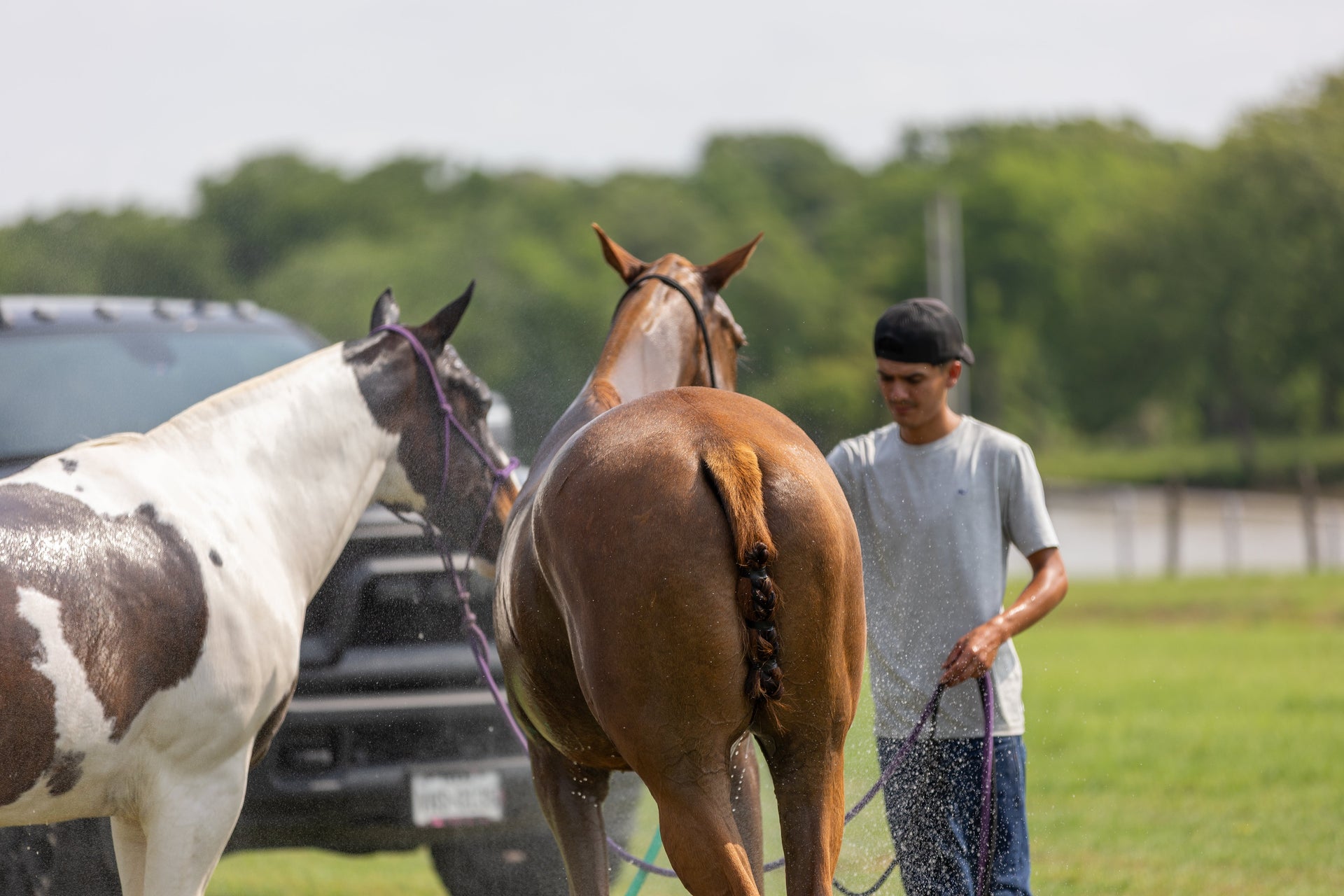Summer Heat Stress in Horses: Spot the Signs & Protect the Gut
June 18, 2025

Summer heat stress can escalate quickly in horses, especially performance athletes. While signs like sweating and fatigue are well-known, what’s less recognized is how heat stress quietly impacts the gut. Recovery also takes longer than most realize: Recent research found that endurance horses often reach their peak body temperature at the end of a ride, while trotters (or horses doing quick sprints) typically peaked 30 to 40 minutes post-exercise (1).
This means that proactive cooling before, during, and after exercise, is essential for equine health and performance.
In this blog, we’ll explore how horses regulate their body temperature, why some are more vulnerable than others, how high temperatures impact gut health, and most importantly, how to keep your horse safe, cool, and thriving all summer long.
Equine Thermoregulation: How Do Horses Cool Down?
The normal body temperature range for an adult horse is 99 to 101.5°F. Because horses generate a large amount of internal heat, especially during exercise, they rely on sweating and respiration to cool down. Horses have one of the highest sweat rates among mammals and can lose up to 4 gallons (15 liters) of sweat per hour on warm days (2).
Unlike humans, who lose high levels of water through sweat, horses produce hypertonic sweat, which is rich in electrolytes. In other words, horse sweat contains high levels of electrolytes, leaving them more vulnerable to electrolyte imbalances and dehydration, particularly during prolonged exertion or heat exposure. Additionally, because electrolyte-depleted cells do not trigger thirst as effectively, horses may not instinctively rehydrate after sweating, unlike humans who crave water after losing large amounts of it in sweat.
This is why it is very important to observe your horse’s individual sweat rate, monitor core and rectal temperature, and assess signs like skin elasticity to gauge hydration status and thermoregulation efficiency.
What is Summer Heat Stress in Horses?
Early Signs of Heat Stress and Heat Stroke in Horses
Heat stress occurs when the horse's natural internal cooling systems become overwhelmed and can no longer keep up with regulating a healthy body temperature. This is most likely to happen in hot, humid environments or following intense physical activity (3). Signs of early equine heat stress include:
-
Increased respiratory rate
-
Increased rectal temperature between 103 to 105°F
-
Tacky gums and reduced skin elasticity
-
Warm, dry, or sticky skin
-
Elevated resting heart rate
-
Lethargy or dullness
-
Decreased appetite
If left unaddressed, heat stress can progress to heat stroke, a very serious and potentially life-threatening condition involving central nervous system dysfunction. Heat stroke is typically characterized by:
-
Disorientation and incoordination
-
Extremely high rectal temperature over 105°F
-
Rapid breathing and heart rate
-
Absent or poor sweating
-
Delayed capillary refill time
-
Increased skin tenting
Not all horses sweat the same, which is why it is so crucial to understand your individual horse. Factors influencing a horse’s heat tolerance include:
-
Age: Older horses may have sweat less and cool down more slowly.
-
Body Condition: Overweight horses retain more heat due to excess fat insulation and can struggle more with cooling.
-
Breed: Research suggests breeds like Arabians are more heat-tolerant, while draft breeds are more susceptible to overheating.
-
Health Conditions: Conditions like anhidrosis (inability to sweat), metabolic disorders, or respiratory issues increase risk.
Related Reading: 4 Steps to Caring for Your Overweight Horse
Quick Diagnostics At Your Fingertips (Literally)!
If you suspect dehydration, contact your veterinarian immediately. Do not wait - the sooner you address the issue, the better. If you are unsure whether your horse is dealing with summer heat stress, try these simple checks:
-
Skin Pinch Test: Gently pinch a fold of skin between your thumb and forefinger on your horse’s neck or shoulder. If it takes more than 2 seconds to flatten and return to normal (i.e. if it remains tented), dehydration is likely, and you should call your veterinarian.
-
Capillary Refill Time: Press your horse’s gums with your thumb. If it takes longer than 2 seconds for the gums to return to a pink color, your horse may be dehydrated, and you should call your veterinarian.
Related Reading: Is Your Horse Dehydrated?
How Does Heat Affect a Horse’s Gut?
Heat Induced Leaky Gut Syndrome in Horses
Here’s something less obvious: Heat stress also impacts the gut.
During exercise in hot conditions, blood flow is redirected away from the digestive tract and toward the muscles, limbs, and skin to help with cooling and continued performance. While this prioritization is necessary, it can leave the gut vulnerable. With less blood flow:
-
The integrity of the gastrointestinal barrier weakens
-
The immune system residing in the gut is compromised
-
A systemic inflammatory response may follow
This chain reaction is referred to as Heat-Induced Leaky Gut Syndrome, or an impaired gut lining in response to high heat.
Dr. Amanda Bradbery, FullBucket Equine Nutritionist and Assistant Professor at Montana State University explains:
“Most horses are able to regulate these processes at rest, but when intense exercise is added to their routine, risk increases. The best way to prevent Heat-Induced Leaky Gut Syndrome is to reduce the duration and intensity of exercise on hot days, be diligent about cool-down and recovery, and provide a diet that helps maintain a healthy intestinal barrier and microbiome. Some studies suggest that a stable gut microbiome can reduce the incidence of heat-induced leaky gut following exercise.”
Shop our veterinarian- and PhD equine nutritionist-formulated equine probiotics, which help stabilize, maintain, and support a healthy gut microbiome here.
Related Reading: A Complete Guide to Muscle Recovery for Horses
What to Feed Horses During Extreme Heat
In cold weather, microbial fermentation of forage in the hindgut helps keep horses warm. While this is ideal in the winter, the high heat increment of forage digestion can be challenging during the summer.
While forage is always essential, increasing roughage in summer can add to heat load, and some horses will naturally reduce forage intake in the summer. So how to keep body condition on your athletic horse during the summer months?
Equine nutritionists always recommend maintaining at least 1% of body weight in forage daily, but if you need to add calories for athletic horses, fat is your friend.
Dr. Bradbery advises, “The best way to increase calories without increasing digestive and metabolic heat production is through fat. Fat is calorie dense, 2.25x more calories than carbohydrates, and has a low-heat increment. This means that its digestion and metabolism produces less heat than long-stem forages making it a great option for performance horses in the summer.”
7 Ways to Safely Keep Your Horse Cool
Hot weather demands proactive care. Here are our best veterinarian- and nutritionist-approved tips to beat the heat:
1) Monitor Water Intake: Know what is normal for your horse when it comes to drinking water. Be cautious of automatic waterers, which do not let you see how much your horse is drinking. Remember the skin pinch test and capillary refill time diagnostic tools, which can help provide a baseline, especially if you use automatic waterers. Always provide access to clean and cool water.
2) Provide Electrolytes: Use a daily electrolyte supplement designed specifically for horses to replenish the essential electrolytes lost in sweat and encourage drinking. We recommend this one, designed by our veterinarians and nutritionists for use on the Four Sixes Ranch.
3) Cold Hose Your Horse Until Their Temperature Drops: Hose the large muscle groups (neck, shoulders, back, rump) with cool (not ice) water after exercise to bring body temperature down.
4) Use a Sweat Scraper: Standing water gets trapped in the horse’s hair and acts as an insulator. Always scrape the water off immediately after hosing.
5) Use Cooling Equipment Wisely: Fans, misting systems, and shaded turnout or stall areas can increase ventilation and maintain a comfortable environment. Ice boots may help cool down the limbs post-exercise, but avoid full-body icing, unless directed by a veterinarian.
6) Train and Acclimatize Smarter: Pay attention to the heat index in your region, which takes both temperature and humidity into consideration, and adjust your training schedule to minimize risk. Early morning or evening rides are best. If traveling, allow time for acclimatization, especially if moving from a cooler to a warmer climate. In cases of extreme temperature differences, acclimatization can take 10 to 14 days. Plan accordingly.
7) Feed Fats To Maintain Body Condition: Always provide forage at least 1% of your horse’s body weight. If your horse needs more calories, use fats, which produce less metabolic heat. Add a specially formulated equine probiotic to support gut health during feed changes and stress.

While horses are equipped with impressive thermoregulation abilities, heat and humidity can overwhelm even the fittest equine athlete. By recognizing early warning signs, supporting gut health, and following smart summer management strategies, you can help your horse stay safe, sound, and strong all season long.
Wishing you health in every area this summer: Gut health, physical health, mental health, and of course, horse health.
About Dr. Amanda Bradbery
Dr. Amanda Bradbery is an Assistant Professor of Equine Nutrition and Physiology at Montana State University and serves as the Lead Equine Nutritionist for FullBucket Health. Her research focuses on smart, science-backed nutritional strategies that support performance longevity, healthy growth and development, and long-term metabolic health. Whether fueling elite equine athletes or nurturing the next generation of young horses, Dr. Bradbery is passionate about turning research into practical, real-world results that make a lasting difference in every horse’s health.

Research Citations
- 1) Continuous Monitoring of the Thermoregulatory Response in Endurance Horses and Trotter Horses During Field Exercise: Baselining for Future Hot Weather Studies, https://pubmed.ncbi.nlm.nih.gov/34512382/
- 2) Oral Electrolyte and Water Supplementation in Horses, https://www.mdpi.com/2306-7381/9/11/626
- 3) Heat stress in horses: a literature review, https://link.springer.com/article/10.1007/s00484-023-02467-7


